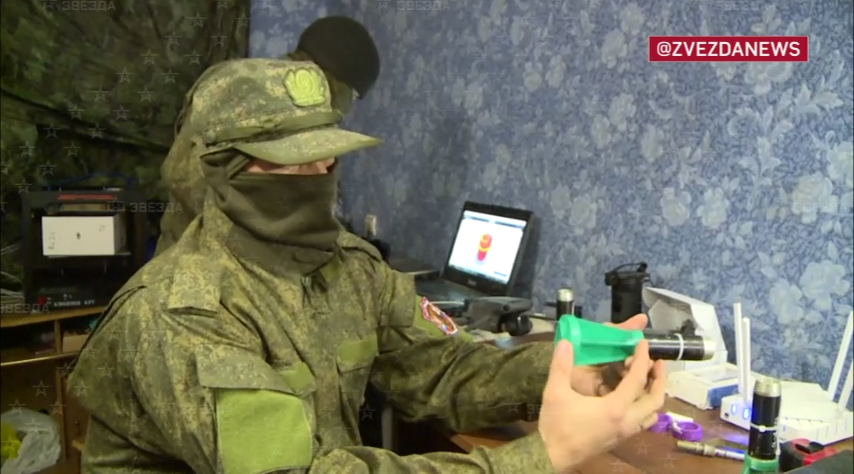The Russian military is employing 3D technology to aid in dropping grenades into enemy trenches from a quadcopter, state-owned media claimed.
Combat operations by UAVs are arguably one of the most essential technological advancements employed in modern-day warfare. Troops on both sides have been using quadcopters to drop grenades on rival positions.
Russian forces appear to have devised a method for precisely striking Ukrainian soldiers in the network of confined trenches. The state-run Zvezda news channel aired a video of the Russian military putting 3D-printed winglets to grenades for stabilization.
A drone hovering above the Ukrainian’s positions can release a shell from an under-barrel grenade launcher straight into the Ukrainian forces’ trenches. The small parts made by a 3D printer enable a smooth dive of munition that ensures a precise strike in the trench.
Preparation of Quadro copter bomblets
Basically, they attach winglets made on a 3D printer to a hand grenade or 30mm grenade for stabilisation.#Russia #ukriane #RussiaUkraineWar pic.twitter.com/nROfAomqbw
— Ashutosh (@radar360in1) November 29, 2022
Soldiers from the 40th Marine Brigade of the Pacific Fleet create these “wings” in a small lab located in an underground shelter. It is quite challenging to place a shell in a trench correctly.
However, with the 3D-printed grenade elements, the munition can be launched directly and very accurately, according to a Russian design engineer with the call sign “Java.”
Furthermore, it is easy to modify drones with such technology. You only need a computer, decent lighting, a standard variety of tools, and a 3D printer to complete the task.

The strike drone’s target’s coordinates are either picked up by another drone deployed simultaneously with it or by radar stations like Sobolyatnik. Thanks to the strong antenna signal, the radar can identify precisely what or who is in various places, such as a person, a tank, or an infantry fighting vehicle.
The Sobolyatnik complex comprises a cable, an antenna, a power supply unit, and a control panel. The weight of the whole setup is roughly 40 kilograms. It only requires five minutes on average to put together and disassemble.
https://www.youtube.com/watch?v=TSuoQzKn1SI&t=8s
It is possible to strike Ukraine’s positions along the whole line of contact with strike drones and advanced technical reconnaissance. Nonetheless, the Ukrainian military has also demonstrated 3D technologies in a similar line.
Ukrainians previously added 3D-printed fins ammunition used in AG-17 grenade launchers to transform them into aerial anti-personnel explosives. On November 29, a video of a Ukrainian DJI drone from the State Border Guard dropping a grenade on a Russian MT-LB surfaced on the internet.
Trench Warfare
Russia is constructing a vast network of trenches to halt further Ukrainian advances. According to a recent UK Ministry of Defense report, Russia dug up new defensive lines 60 kilometers from the frontline in preparation for the impending winter.
During World War One, trench warfare evolved into static combat in which neither side could advance. Machine guns and rapid-fire artillery were new weapons that devastatingly affected forces moving through expansive terrain and made cavalry attacks risky.
Even massive artillery bombardments that lasted for days wouldn’t harm entrenched troops. Trench warfare provided the defenders with a clear advantage.
However, videos released by the Ukrainian military demonstrate how defenseless entrenched troops are against a novel tactic: highly accurate grenade drops from quadcopter drones. Armed forces can use drones to attack enemy positions far from the frontlines and the main battle area.
Because the procedure has been perfected, consumer quadcopters like the DJI Mavic 3 are now Ukraine’s standard bombers equipped with weapons modified from Vog-17 anti-personnel grenades.
https://www.youtube.com/watch?v=-edqE20kunA&t=18s
Ukrainian and Russian operators have mastered the art of hitting precise targets from a few hundred meters in the air. Furthermore, footage of the militaries of Russia and Ukraine deploying explosive-loaded miniature drones as improvised loitering weapons are becoming more and more common.
These can fly through doorways and tunnels and can move in small spaces. They might not be nearly as effective as modern quadcopters driven by artificial intelligence (AI), but they are affordable, readily available, and ready to enter earthworks.
- Contact the author at ashishmichel(at)gmail.com
- Follow EurAsian Times on Google News